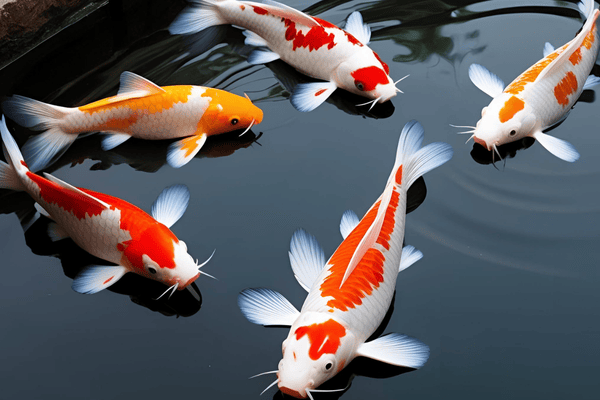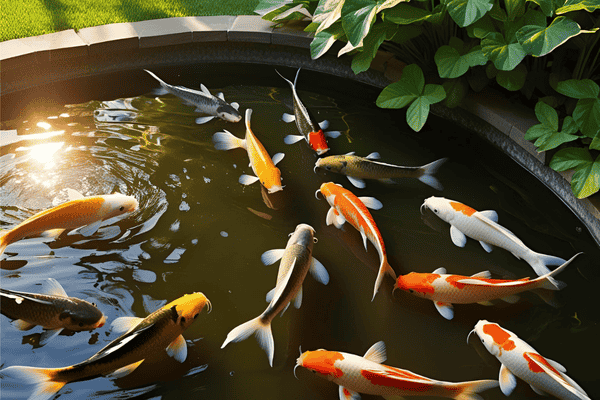Intro
Feeding koi fish may seem simple, but it is more than just tossing food into the water. Koi fish have special dietary needs, and feeding them the right way keeps them healthy, active, and colorful. Overfeeding can make the water dirty, while underfeeding can weaken them.
You also need to know what food suits them in different seasons. Should you feed them daily? What is the best food? How much is too much? In this guide, you will learn everything about feeding koi fish correctly, so they grow beautifully and live a long, happy life in your pond.
Feeding Koi Fish: The Ultimate Guide

Koi fish are not just beautiful to look at; they also need the right diet to stay healthy and vibrant. If you’re new to koi keeping, you might wonder, What do koi fish eat? How much should I feed them? Can I give them human food? In this guide, I’ll walk you through everything you need to know about How to feed koi fish the right way.
What Do Koi Eat?
Koi fish are omnivores, meaning they eat both plants and small animals. In the wild, they munch on algae, insects, worms, and even small crustaceans. When kept in ponds, koi need a balanced diet to thrive.
General Information on Feed Koi Fish
Feeding your koi fish properly is essential for their health and happiness. Here are some key points to keep in mind:
- Overfeeding can pollute the water and harm your fish.
- Koi have no stomachs, so they digest food quickly.
- Their diet should change with the seasons.
- High-quality food makes a huge difference in their growth and color.
Koi Fish Food Quality
High-Quality Koi Fish Food
Good koi food contains:
- High protein for growth and muscle development.
- Spirulina for vibrant colors.
- Wheat germ for easy digestion.
- Essential vitamins and minerals to boost immunity.
Low-Quality Koi Fish Food
Avoid cheap, low-quality food that contains:
- Fillers like corn and wheat middlings.
- Artificial colors or preservatives.
- Low protein content.
What Do Koi Fish Eat Naturally?

In the wild, koi fish eat:
- Algae
- Small insects
- Worms
- Plant matter
- Small crustaceans
You can try to replicate their natural diet by adding live food or treats.
What You Can Feed Koi Fish
Koi can eat:
- Pellets or flakes
- Fruits like watermelon or oranges
- Vegetables like lettuce or peas
- Shrimp and worms
- Special koi treats
Types of Koi Food
There are different types of koi food, each serving a specific purpose:
- Staple food – Everyday pellets or flakes
- Growth food – High in protein for young koi
- Color-enhancing food – Contains spirulina for vibrant colors
- Wheat germ food – Good for colder seasons
- Floating vs. sinking food – Floating food helps you observe their feeding
Feeding Frequency
How often should you feed your koi fish? It depends on the temperature and season:
- Summer (Warm Water) – 2-4 times a day
- Spring & Fall (Mild Water) – 1-2 times a day
- Winter (Cold Water) – Stop feeding below 50°F (10°C)
Portion Control
Koi should eat only as much as they can consume in 5 minutes. Leftover food can rot and pollute the pond.
Adjusting Diet

You may need to adjust your koi’s diet based on:
- Growth stage
- Season changes
- Health conditions
- Water temperature
Treats & Natural Foods
You can occasionally feed your koi treats like:
- Oranges (boosts vitamin C)
- Watermelon
- Shrimp
- Mealworms
Tips for Feeding Koi Fish

- Feed at the same time each day.
- Use a feeding ring to control food spread.
- Remove uneaten food to keep water clean.
- Observe your koi’s eating habits to spot health issues.
Important Considerations
- Water quality affects digestion.
- Koi can recognize their owners. Hand-feeding builds trust.
- Balance is key. Don’t feed too much protein or carbs.
Seasons Affect What Koi Fish Eat
Water temperature changes koi’s metabolism. During winter, they need fewer proteins, while in summer, they need high-energy food.
The Best Koi Fish Food
Here are some of the best foods for koi fish:
- Spirulina Algae – Boosts immune system and color
- Wheat Germ – Easy to digest in cooler temperatures
- Brine Shrimp – Provides protein and nutrients
- Fish Food – Specially formulated pellets
- Hi Silk 21 – Helps in muscle growth
- Manda Fu – Premium Japanese koi food
- Some Human Food – Fruits and vegetables
What Not to Feed Koi Fish
Avoid feeding koi:
- Bread
- Dairy products
- Meat
- Processed foods
- Sugary snacks
What Influences a Koi Fish’s Diet?
- Water temperature
- Age of the koi
- Pond environment
- Activity level
Koi Fish Digestive System
Koi don’t have a stomach, so they digest food quickly. That’s why frequent small meals are better than large ones.
Factors for How Much and How Often to Feed Koi Fish
Consider:
- Temperature
- Growth stage
- Water quality
How Much Koi Food Should I Feed My Fish?
Follow the 5-minute rule – if food remains after 5 minutes, reduce the portion.
How to Feed Koi Fish
- Choose high-quality food.
- Feed at the same time daily.
- Watch their behavior while eating.
Koi Feeding Tips
- Hand-feeding can build trust.
- Feeding rings keep food in one place.
- Never overfeed!
Seasonal Feeding Guidelines
- Spring/Fall – Feed wheat germ-based food.
- Summer – High-protein diet.
- Winter – Stop feeding below 50°F.
Temperature and Koi Fish Feeding
- Above 70°F – High protein
- 50-70°F – Wheat germ
- Below 50°F – No feeding
Koi Fish Food Automatic Feeders
Auto feeders can help keep a consistent feeding schedule.
Pros
- No risk of overfeeding
- Keeps koi on a schedule
- Useful for vacations
Cons
- Expensive
- Can malfunction
- Less bonding time with koi
How Auto Feeders Work
They dispense a set amount of food at scheduled times, reducing waste and maintaining a healthy diet.
Keep Your Pond at Its Best So Your Koi Fish Can Be Healthy and Happy
A clean pond and a balanced diet will keep your koi fish healthy, active, and colorful. Follow these feeding tips, choose high-quality food, and enjoy watching your koi thrive!
Faq
No.1 What food is good for koi growth?
High-protein foods like spirulina, wheat germ, brine shrimp, Hi Silk 21, and high-quality koi pellets are best for koi growth.
No.2 What does a koi fish eat?
Koi eat algae, insects, worms, shrimp, vegetables, fruits, and specially formulated koi pellets.
No.3 What is the feeding schedule for koi fish?
Above 70°F (21°C): 2-4 times daily
50-70°F (10-21°C): 1-2 times daily
Below 50°F (10°C): Stop feeding (hibernation phase)
No.4 What is the nutritional requirement for koi fish?
Koi need 35-40% protein, 5-10% fats, vitamins (A, C, D, E), and minerals for strong immunity and vibrant color.





3 Responses
Entrei pelo http://www.brabet e já adorei! Site fácil de navegar, bônus interessantes e um suporte que responde rápido. Vale a pena conferir! http://www.brabet
GMC… ouvi falar desse site por aí. Alguém já jogou? Parece interessante pra passar o tempo e quem sabe ganhar uma grana! gmc